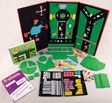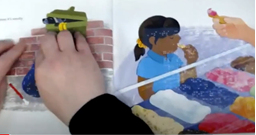Connections to the BC Curriculum – Core Competencies
 The British Columbia K-12 Curriculum emphasizes Critical and Reflective Thinking as a core competency. Critical and reflective thinking includes students “[making] judgments based on reasoning: […] consider options; analyze these using specific criteria, and draw conclusions and make judgments.” The curriculum identifies three facets of critical and reflective thinking:
The British Columbia K-12 Curriculum emphasizes Critical and Reflective Thinking as a core competency. Critical and reflective thinking includes students “[making] judgments based on reasoning: […] consider options; analyze these using specific criteria, and draw conclusions and make judgments.” The curriculum identifies three facets of critical and reflective thinking:
- Analyze and critique
- Question and investigate
- Develop and design
Orientation and Mobility Skills – Students with Visual Impairments
Students with visual impairments need conceptual understanding, skills, and tools to understand and move through their environment at home, at school, and in the community. Orientation and mobility instruction, provided by a trained orientation and mobility specialist, may encompass concept development, use of mobility devices, techniques for moving safely through the environment, and understanding when and how to seek additional information or assistance. Ultimately, the goals of O&M is to allow a student to travel as independently or interdependently as possible (Fazzi, 2014). Direct instruction in these skills promotes independence and safely.
Examples of Orientation and Mobility Skills
- Using techniques to move safely through one’s home and school environment independently.
- Listening to traffic and other cues to determine the type of intersection and the safest time to cross.
- Learning to ask for assistance and direct a peer or teacher how to provide help appropriately.
Resources to Support Instruction
PRCVI Library Catalogue
- American Printing House for the Blind. Tactile Town: 3-D and O&M Graphics Kit. Louisville, KY: American Printing House for the Blind. [Resource Kit]
 Kit of interactive materials for creating a variety of travel environments (e.g., residential, commercial) with road and safety signage. Great for pre-teaching and reviewing concepts in a lower risk setting/manner.
Kit of interactive materials for creating a variety of travel environments (e.g., residential, commercial) with road and safety signage. Great for pre-teaching and reviewing concepts in a lower risk setting/manner. - American Printing House for the Blind. Picture maker: Wheatley tactile diagramming kit. Louisville, KY: American Printing House for the Blind. [Resource Kit]
- Useful for instruction and assessment of positional concepts, single-block orientation, grid-pattern development, building and room familiarization, and to illustrate intersection layouts.
- Fazzi, D. L. & Petersmeyer, B. A. (2001). Imagining the possibilities: Creative approaches to orientation and mobility instruction for persons who are visually impaired. New York, NY: American Foundation for the Blind. [Professional Text]
- Text applying O&M concepts, strategies, and techniques to K-12 oriented instruction - contains plans and suggestions for O&M instruction and assessment.
- Jacobson, W. H. (2013). The art and science of teaching orientation and mobility to persons with visual impairments (2nd ed.). New York, NY: AFB Press. [Professional Text]
- Introductory text to the teaching of O&M that includes basic, intermediate, and advanced techniques for indoor and outdoor travel
- McCarthy, T. (2016). Teaching street crossing to students with visual impairments. Louisville, KY: APH Press. [Professional Text]
- Guidebook for teaching street crossings using a variety of instructional strategies like modeling, direct instruction, guided practice, and reinforcement.
- Pogrund, R., Sewell, D., Anderson, H., et al. (2012). Teaching Age-Appropriate Skills: An Orientation and Mobility curriculum for students with visual impairments (3rd ed.). Austin, TX: Texas School for the Blind and Visually Impaired. [Professional Text]
- Curriculum with goals, objectives, and teaching strategies across several travel environments. Includes a supplement on street crossing strategies.
- Pogrund, R. L. & Griffin-Shirley, N. (2018). Partners in O&M: supporting orientation and mobility for students who are visually impaired. New York, NY: American Foundation for the Blind. [Professional Text]
- An introductory text to the field of O&M with a focus on the roles of the various members of a student's team with a special emphasis on families.
- Zatta, M. C., et al., (2014). Alternate routes: Adapting orientation and mobility techniques. Watertown, MA: Perkins School for the Blind. [Professional DVD]
- DVD with companion booklet on adaptations to common O&M techniques and skills such a human guiding and trailing.
Web-Based Resources
- Atlantic Provinces Special Education Authority (2019). Orientation and Mobility Delivery Guidelines. Halifax, NS: APSEA.
- This resource from APSEA outlines common O&M skills and sets guidelines for which skills can be introduced, taught, and reinforced by the O&M Specialist or Teacher of Students with Visual Impairments.
- British Columbia Ministry of Education. Framework for independent Travel: A resource for orientation and mobility instruction. Retrieved from https://www2.gov.bc.ca/assets/gov/education/kindergarten-to-grade-12/teach/teaching-tools/inclusive/fit.pdf
- Framework document for planning O&M instruction in K-12 developed by British Columbia-based O&M Specialists.
- Brauner, D. (2020, March 13). Virtual Instruction: O&M. Retrieved from https://www.perkinselearning.org/technology/blog/virtual-instruction-om
- Diane from Paths to Technology has gathered various apps, resources, and activity suggestions for working on O&M skills while in-person instruction may be limited or unavailable due to current COVID-19 restrictions.
- PRCVI. O&M Sharing Day - Victor Stream and Favourite Resources. Retrieved from https://www.prcvi.org/resources/the-expanded-core-curriculum/orientation-and-mobility/orientation-and-mobility-sharing-days/
- Web page with a summary and resources from an O&M Sharing Day. Special thanks to Steve from Canadian Assistive Technology for presenting on the Victor Trek!
- PRCVI. Mobility Monday - Remote Learning and O&M. Retrieved from https://prcvi.org/resources/the-expanded-core-curriculum/orientation-and-mobility/mobility-monday-remote-learning-for-om/
- Web page with resources from our first remote O&M Sharing Day. Resources contributed by BC O&M Specialists serving students remotely during the global pandemic of 2020.
- Soundscape Community. (2023). Soundscape Community. Retrieved from https://soundscape.services//
- Based on the former Microsoft Soundscape app, Soundscape Community is a free app that uses 3D audio technology to enhance awareness of what’s around you in the environment. The app can be used to anticipate upcoming intersections, place sound beacons in the environment, and navigate to points of interest.
- Perkins School for the Blind (2020). Expert Q&A: CVI and O&M [YouTube; 58.15]. Retrieved from: https://www.youtube.com/watch?v=xZNwD_M0yug
- This recorded webinar from Perkins School through their CVI-NOW portal covers essential skills and concepts for O&M with students with cortical/cerebral visual impairment including body awareness, safe navigation, dealing with complex environments, anxiety in new places, O&M for wheelchair users, and white cane use.
- Perkins School for the Blind. O&M and CVI. Watertown, MA: Perkins School for the Blind. Retrieved from https://www.perkinselearning.org/videos/webinar/om-and-cvi
- Webinar on specific adaptations and modifications to O&M assessment and instruction for students with cortical visual impairment.
- Perkins School for the Blind. Wheelchair Orientation & Mobility. Watertown, MA: Perkins School for the Blind. Retrieved from https://www.perkinselearning.org/videos/webcast/wheelchair-orientation-mobility
- Webinar from Scott Crawford, COMS on O&M instruction with learners who use power wheelchairs. Topics include navigating tight spaces and curb ramps, and public transportation.
- San Francisco Lighthouse. TMAP: Tactile Maps Automated Production. Retrieved from https://lighthouse-sf.org/tmap/
- Are you introducing outdoor map reading to your student? TMAP is an online tool that uses map coordinates to automatically generate a tactile map file to be embossed on a graphics-capable embosser (such as a Tiger).
References
Fazzi, D. L. (2014). Orientation and Mobility. In Allman, C. B., Lewis, S., & Spungin, S. J. (eds.). ECC essentials: Teaching the expanded core curriculum to students with visual impairments (pp. 248-282. New York, NY: AFB Press.
 My City Speaks [Book]
My City Speaks [Book]
 Orientation and mobility is the ability to navigate one’s environment safely and efficiently. Orientation and mobility (“O&M” for short) skills involve knowing where one is in the relation to other objects and people in the environment (orientation) and knowing how to navigate to the desired destination using mobility skills and devices (mobility). Please see below for important information regarding O&M service delivery:
Orientation and mobility is the ability to navigate one’s environment safely and efficiently. Orientation and mobility (“O&M” for short) skills involve knowing where one is in the relation to other objects and people in the environment (orientation) and knowing how to navigate to the desired destination using mobility skills and devices (mobility). Please see below for important information regarding O&M service delivery: Check out the Orientation and Mobility Skills section in #Outreaching - the blog of the PRCVI Outreach Team.
Check out the Orientation and Mobility Skills section in #Outreaching - the blog of the PRCVI Outreach Team. The
The  Kit of interactive materials for creating a variety of travel environments (e.g., residential, commercial) with road and safety signage. Great for pre-teaching and reviewing concepts in a lower risk setting/manner.
Kit of interactive materials for creating a variety of travel environments (e.g., residential, commercial) with road and safety signage. Great for pre-teaching and reviewing concepts in a lower risk setting/manner.